NCERT Exemplar Solutions: Light | Science Class 8 PDF Download
Multiple Choice Questions
Q.1. Part of the eye which controls the light entering is called
(a) iris
(b) cornea
(c) lens
(d) retina
Ans: a
Solution: Iris is a dark muscular structure exists behind the cornea. Its function is to control the entry of light.
Q.2. We can see a non-luminous object when light:
(a) emitted by the object falls on the eye.
(b) is reflected from the object towards our eye.
(c) completely passes through the object.
(d) gets completely absorbed by the object.
Ans: b
Q.3. Light is falling on surface S1, S2, S3 as shown in Fig.16.1.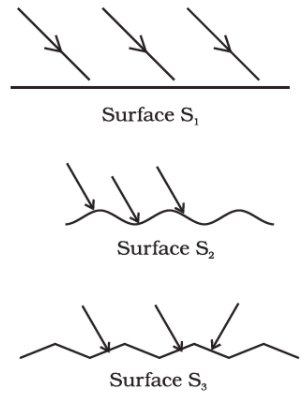
Surfaces on which the angle of incidence is equal to the angle of reflection is/are
(a) S1 only
(b) S1 and S2 only
(c) S2 and S3
(d) all the three surfaces
Ans: d
Solution: Laws of reflection are always followed irrespective of the surface of the object hence the angle of incidence is equal to the angle of reflection.
Q.4. A tiny mirror M is fixed on a piece of cardboard placed on a table. The cardboard is illuminated by light from a bulb. The position of the eye with respect to the position of the bulb is shown in Fig.16.2 as A, B, C and D. In which position mirror will be visible?
(a) A
(b) B
(c) C
(d) D
Ans: a
Solution: In case of A ray of light from A strikes mirror and gets reflected back to make an angle of incidence and angle of reflection equal.
Q.5. A small hole P is made in a piece of cardboard. The hole is illuminated by a torch as shown in Fig. 16.3. The pencil of light coming out of the hole falls on a mirror.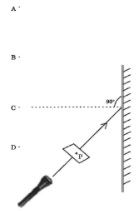
At which point should the eye be placed so that the hole can be seen?
(a) A
(b) B
(c) C
(d) D
Ans: a
Solution: The eye should be placed at position A because the hole can be seen only when the angle of incidence is equal to the angle of reflection.
Q.6. Two mirrors A and B are placed at right angles to each other as shown in Fig.16.4.
A ray of light incident on mirror A at an angle of 250 falls on mirror B after reflection. The angle of reflection for the ray reflected from mirror B would be
(a) 250
(b) 500
(c) 650
(d) 1150
Ans: c
Solution: The angle of reflection for the ray reflected from mirror B will be 65° because reflected ray from mirror A forms incident ray on mirror 6 and then reflected back by an angle of 65°.
Q.7. Which of the following statements is correct regarding rods and cones in the human eye?
(a) Cones are sensitive to dim light.
(b) Cones are sensitive to bright light.
(c) Rods are sensitive to bright light.
(d) Rods can sense colour.
Ans: b
Solution: Cones are sensitive to bright light hence they sense the colour whereas rods are sensitive to dim light and they cannot sense colour.
Q.8. In the figure of the human eye (Fig.16.5), the cornea is represented by the letter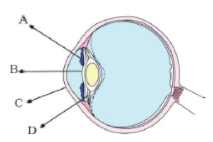
(a) A
(b) B
(c) C
(d) D
Ans: c
Solution:
1. Iris
2. Lens
3. Cornea
Very Short Answer Questions
Q.9. Name the part of the eye which gives colour to the eyes
Ans: Iris the part of the eye which gives colour to the eyes.
Q.10. Boojho while waving his hand very fast in front of his eyes, observes that his fingers appear blurred. What could be the reason for it?
Ans: Persistence of vision is the reason for the blurred vision of Boojho while waving his hand very fast in front of his eyes, observes that his fingers appear blurred.
Q.11. How many times is a ray of light reflected by two plane mirrors placed parallel and facing each other?
Ans: An infinite number of times a ray of light reflected by two plane mirrors placed parallel and facing each other.
Q.12. The angle between the incident ray and the reflected ray is 60°. What is the value of the angle of incidence?
Ans: The angle of reflection is equal to the angle of incidence. Since Angle of incident ray+ Angle of reflected ray is 60°.
The angle of incidence = 30°
Q.13. The distance between the object and its image formed by a plane mirror appears to be 24 cm. What is the distance between the mirror and the object?
Ans: The distance will be 12 cm
Object + image formed = 24 cm
Object + mirror = 12 cm
Short Answer Questions
Q.14. What happens to light when it gets dispersed? Give an example.
Ans: When the light gets dispersed it is split into its constituent colours. Ex: rainbow.
Q.15. Draw Fig.16.6 showing the position of the plane mirror. Also, label the angle of incidence and angle of reflection on it.
Ans: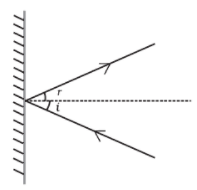
Q.16. Look at Fig.16.7. Can the image of the child in it be obtained on a screen?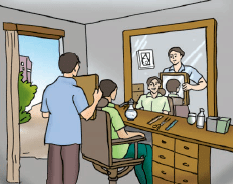
Ans: No, the image of the child cannot be obtained on a screen because the image is a virtual image.
Q.17. Eyes of the nocturnal birds have large cornea and a large pupil. How does this structure help them?
Ans: They can see objects even in the faint light. As a large pupil and large cornea allow more light to enter their eyes.
Q.18. What kind of lens is there in our eyes? Where does it form the image of an object?
Ans: Our eyes have a convex type of lens and the image is formed on the retina.
Q.19. Which part of the eye gets affected if someone is suffering from cataract? How is it treated?
Ans: If a person is suffering from cataract their eye lens will be cloudy. Cataract can be treated by replacing the opaque lens by an artificial lens.
Long Answer Questions
Q.20. Boojho planned activity to observe an object A through pipes as shown in Fig. 16.8, so that he could see objects which he could not directly see.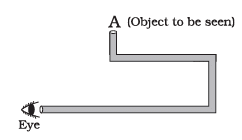
(a) How many mirrors should he use to see the objects?
(b) Indicate the positions of the mirrors in the figure.
(c) What must be the angle with respect to the incident light at which he should place the mirrors?
(d) Indicate the direction of the rays in the figure.
(e) If any of the mirrors are removed, will he be able to see the objects?
Ans: (a) Three mirrors should he use to see the objects.
(b) 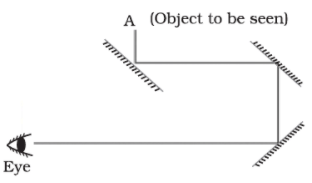
(c) 45°
(d) 
(e) He will not be able to see the objects.
Q.21. There is a mistake in each of the following ray diagrams given as Fig. 16.9 a, b, and c. Make the necessary correction (s).
Ans: The Fig. in all the three cases after correction should be as in the given figure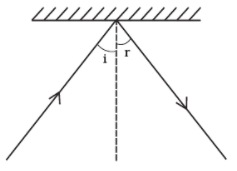
Q.22. Explain the process which enables us to perceive motion in a cartoon film.
Ans: Carton movie is actually a projection of a static picture. 24 pictures per second are shown in a specific order which gives us the perception of movement.
Q.23. How is the phenomenon of reflection used in making a kaleidoscope? What are the applications of a kaleidoscope?
Ans: The kaleidoscope gives a number of images formed by reflection from the mirrors inclined to one another. Designers and artists use kaleidoscope to get ideas for new patterns to design wallpapers, Jewellery and fabrics.
Q.24. Fig. 16.10 shows the word REST written in two ways in front of a mirror. Show how the word would appear in the mirror.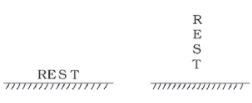
Ans: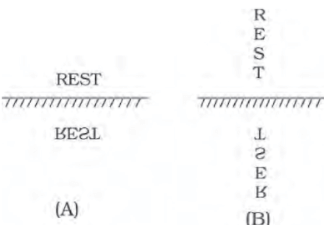
Q.25. Write down the names of parts of the eye in the blank spaces shown in Fig. 16.10.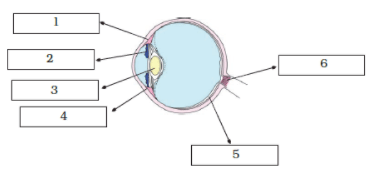
Ans: 1. Ciliary muscle
2. Iris
3. Lens
4. Cornea
5. Retina
6. Optic Nerve
|
90 videos|273 docs|44 tests
|
FAQs on NCERT Exemplar Solutions: Light - Science Class 8
| 1. What is light and how does it travel? |  |
| 2. What is the difference between reflection and refraction of light? |  |
| 3. How does a lens form an image? |  |
| 4. What is the phenomenon of dispersion of light? |  |
| 5. How does the human eye perceive colors? |  |

|
Explore Courses for Class 8 exam
|

|

















